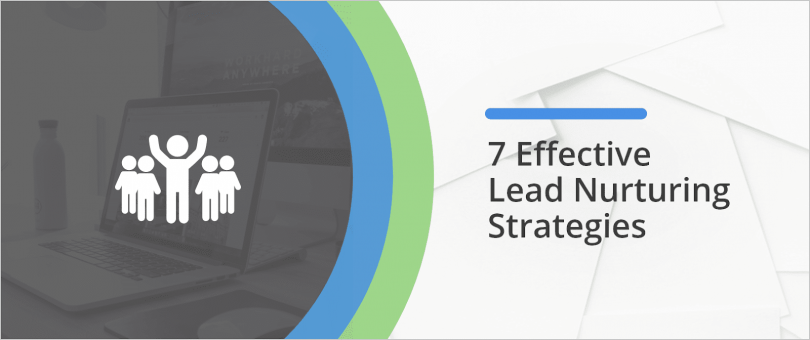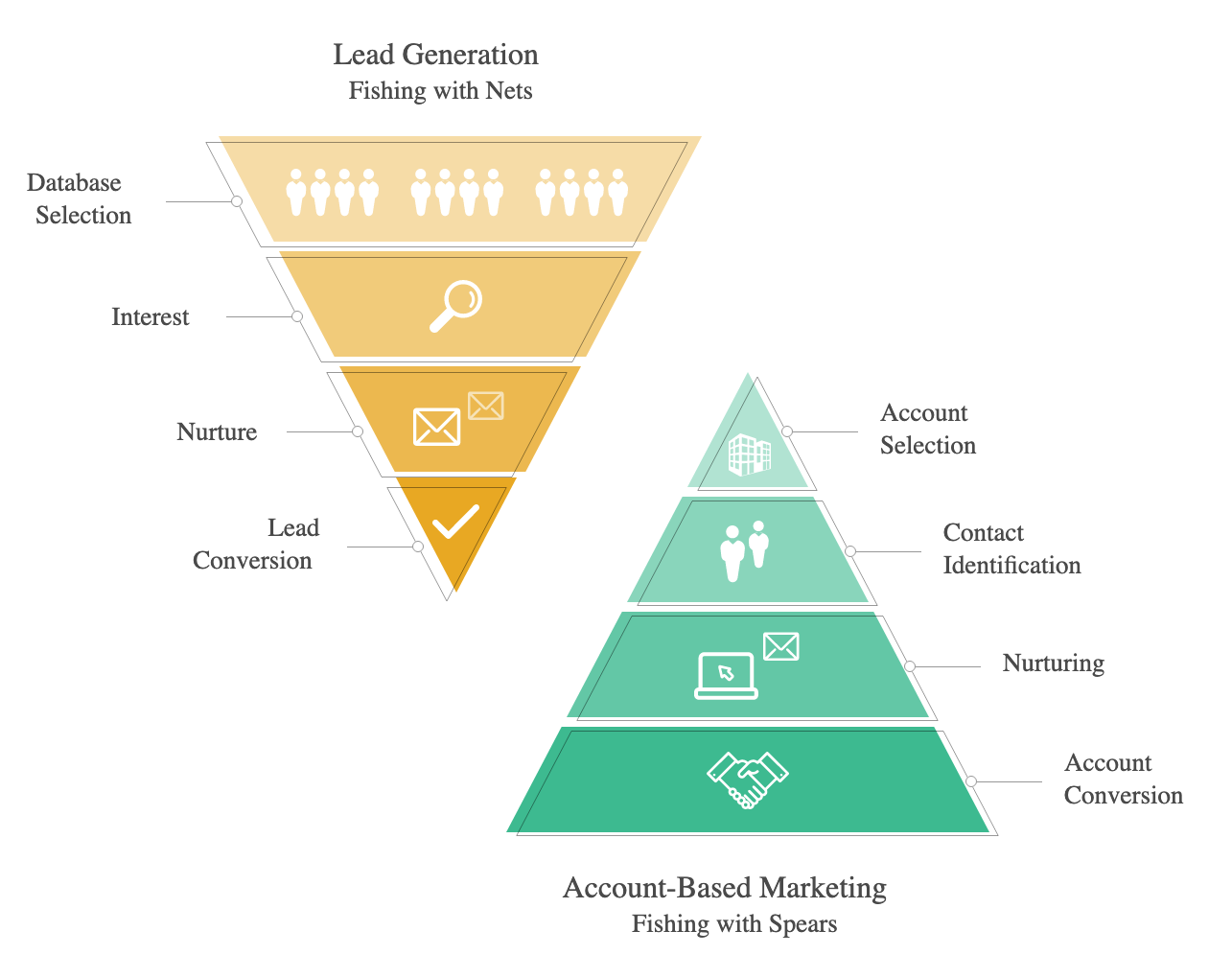As companies adopt inbound marketing as a way to generate more leads, the importance of having an effective lead nurturing strategy becomes very clear. In most cases only a relatively small percentage of your inbound leads will be ready to make an immediate purchase, leaving upwards of 90% of your inbound leads on the table.
Implementing an effective lead nurturing strategy can have a huge impact on the results of your inbound marketing strategy.
In 2018, lead generation, sales, and lead nurturing were the top three organizational objectives for content marketers.
How to Nurture Leads
Lead nurturing is the purposeful process of engaging a defined target group by providing relevant information at each stage of the buyer’s journey.
You want to actively move the prospects you’ve created through your marketing and lead generation efforts, to the point where they become paying customers. Some tactics on how to nurture leads are through targeted content, multi-channel nurturing, multiple touches, timely follow-ups, and personalization.
Despite the clear benefits of lead nurturing, marketers can struggle to build the right strategy around it. According to the 2019 Lead Nurturing & Acceleration Survey, 60% of respondents gave their nurture programs a failing grade.
There’s a huge opportunity for savvy marketers like you to implement effective lead nurturing strategies and gain an advantage over your competition.
So you are probably wondering…
- Which lead nurturing tactics work best?
- What do super successful marketers do differently?
- Or how do I get started with lead nurturing?
Lead nurturing is of course just one component that goes into executing an inbound marketing strategy. If you’d like to learn what super successful inbound marketers are doing differently to attract traffic, convert leads and close customers you can check out this comprehensive resource – An Epic Guide to Creating an Inbound Marketing Strategy.
Now let’s get down to it – we’ve read through dozens of reports, dug into the most recent data about lead nurturing and compiled this list of the seven amazingly effective lead nurturing tactics.
7 Amazingly Effective Lead Nurturing Tactics
1. Leverage targeted content.
When it comes to lead nurturing, one size certainly does not fit all. As the research proves, strategically nurturing your leads using targeted content can significantly improve the results of your inbound marketing strategy.
Using targeted content for lead nurturing may seem obvious, but it’s something that marketers are struggling with. Last year Forrester Research reported that 33% of B2B marketers cite “targeted delivery of content” (i.e., delivering the right content, to the right people, at the right time) as their biggest lead nurturing challenge.
There are a few prerequisites for using targeted content for lead nurturing. First of all, you need to understand each of your unique buyer personas. Of course, you then need to create an assortment of targeted content designed to nurture each of your personas based on their interests, goals, objectives, and marketing triggers.
Lastly, you need to have a marketing automation platform in place to help you identify, segment and target your unique buyer personas as you scale your inbound marketing strategy.
2. Use multi-channel lead nurturing techniques.
In the past, most lead nurturing strategies involved setting up a simple email drip campaign that would send out generic emails to a list of prospects.
Today, marketers like you are looking for new lead nurturing tactics and technologies that go beyond the limits of email. With the help of powerful marketing automation platforms, savvy marketers are now executing multi-channel lead nurturing strategies.
Effective multi-channel lead nurturing most commonly involve a combination of marketing automation, email marketing, social media, paid retargeting, dynamic website content and direct sales outreach. Because there are so many tactics involved, to execute this properly, you really need to ensure that your sales and marketing teams are well aligned and working cohesively.
3. Focus on multiple touches.
While the buyers journey for every product and service can be quite different, research from the Marketing Lead Management Report indicates that on average, prospects receive ten marketing touches from the time they enter the top of funnel until they’re a closed won customers.
Interestingly, another research study from Demand Gen suggests that 49% of marketers include less than five touches in their lead nurturing programs. If you’re in this category, it might be time to revamp your lead nurturing efforts a bit.
As you can imagine, the most successful lead nurturing strategies deliver content that helps prospects progress through the buyer’s journey by addressing common questions and concerns. In addition to email tactics, consider how you can use a mix of content types like social media, blog posts, whitepapers, interactive calculators, or even direct mail, to nurture your prospects into customers.
4. Follow up with leads in a timely manner.
The benefits of immediate follow up calls seem quite evident, but most organizations still aren’t acting very quickly. A recent article in Harvard Business Review highlighted the surprisingly slow response times of most US based companies. Here are a few benchmarks from the study which included feedback from more than 2,240 US companies:
- The average first response time of B2B companies to their leads was 42 hours
- Only 37% of companies responded to their leads within an hour
- 24% of companies took more than 24 hours
- 23% of the companies never responded at all
Automated lead nurturing can help you reach large groups of prospects, but a timely followup email or a phone call is still quite often the best way to convert inbound leads into qualified sales opportunities. As several research studies have shown, the odds of converting a lead into a sales opportunity are exponentially higher when the lead is contacted immediately following a website conversion.
When you make a timely, well researched call to an inbound lead it’s far more effective than any volume of cold calling. You know exactly what the prospects is researching based their recent browsing behaviour and you also have enough information about the prospect to do some initial research about the organization they work for and their specific role within the company.
5. Send personalized emails.
Several research studies indicate that email marketing continues to be the most effective tactic for lead nurturing.
The research also consistently shows that personalization tends to produce significantly better results than generic marketing. A study by Accenture found that 41% of consumers switched businesses due to a lack of personalization.
As highlighted in this helpful blog post, there are all kinds of ways you can personalize your emails to improve your lead nurturing strategy. You can send triggered emails when someone downloads your gated content, clicks on links in your emails, visits certain pages on your website, or when they demonstrate a high level of engagement.
When you combine the power of marketing personalization with behavioral triggered emails you can deliver the right marketing messages to the right people, at exactly the right times.
6. Use lead-scoring tactics.
For those who are new to the concept of lead scoring, it is a methodology used to rank prospects against a scale that represents the perceived value each lead represents to the organization.
Lead scoring can be implemented in most marketing automation platforms by assigning numeric values to certain website browsing behaviors, conversion events, or even social media interactions.
The resulting score is used to determine which leads should be followed up with directly by a sales rep or which leads need to be nurtured further down the funnel.
Based on this research, it seems as though lead scoring is an effective lead nurturing tactic that most marketers simply aren’t taking advantage of yet.
7. Be sure your sales and marketing strategies are aligned.
According to a study by market research firm CSO Insights, when both sales and marketing share responsibility for lead nurturing, companies experience a significant financial boosts. In fact, organizations with tightly aligned sales and marketing teams experience 36% higher customer retention rates.
In order for both sales and marketing to contribute to lead nurturing you’ll need to identity when prospects should be transitioned between teams as they progress through the funnel. In creating your lead nurturing strategy, think about how you can use triggers like lead scoring, page views, workflow enrollment, conversion events or sales contact to transition leads from automation to direct one-on-one outreach.
The shared expectations, responsibilities and goals for this collaboration between sales and marketing should be outlined in a sales and marketing service level agreement (SLA). Creating a formal sales and marketing SLA will help the two teams hold each other accountable for converting leads and effectively nurturing them into paying customers.
Leveraging Lead Nurturing Tactics
In review, let’s quickly recap the seven most effective lead nurturing tactics:
1. Targeted content: Content intrigues, entertains, and delights audiences that could become qualified leads.
2. Multi-channel lead nurturing: Try to reach your audiences on multiple online channels, rather than just relying on email.
3. Multiple Touches – Prospects receive an average of 10 touches from the time they enter the top of the funnel until they’re a closed-won customer.
4. Timely Follow Ups: The odds of a lead entering the sales process, or becoming qualified, are much greater when contacted within five minutes versus 30 minutes after an inbound lead converts on your website.
5. Personalized Emails: Personalization benefits both your marketing and your customer retention.
6. Lead Scoring: This strategy helps you determine which leads you should really take time to follow up with.
7. Sales and Marketing Alignment: Organizations with tightly aligned sales and marketing teams experience 36% higher customer retention rates.
REF:Hubspot![]()



